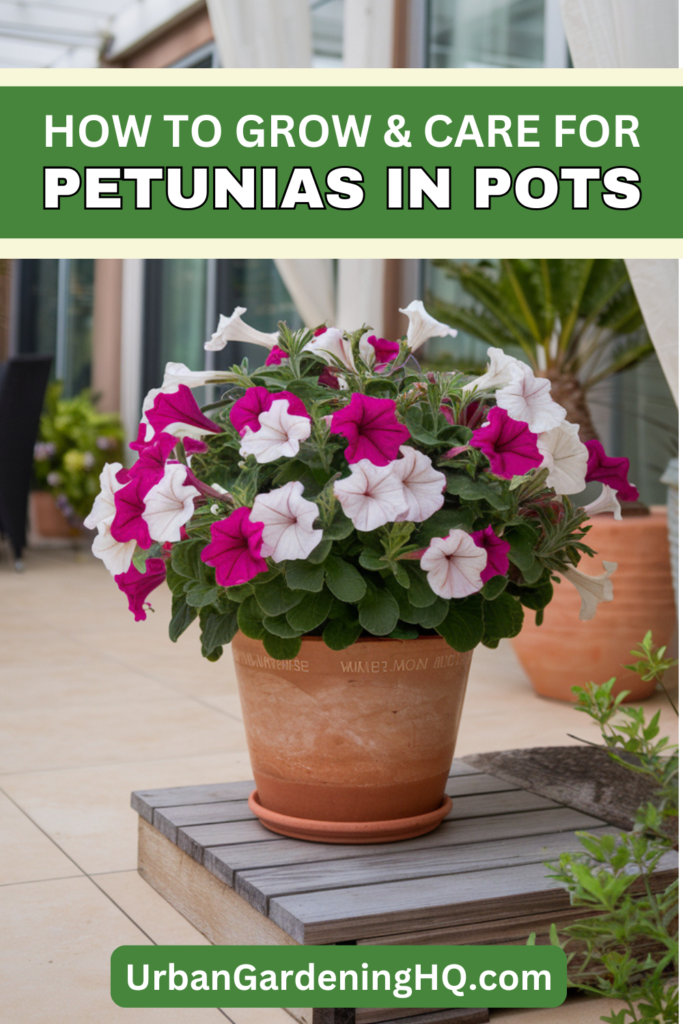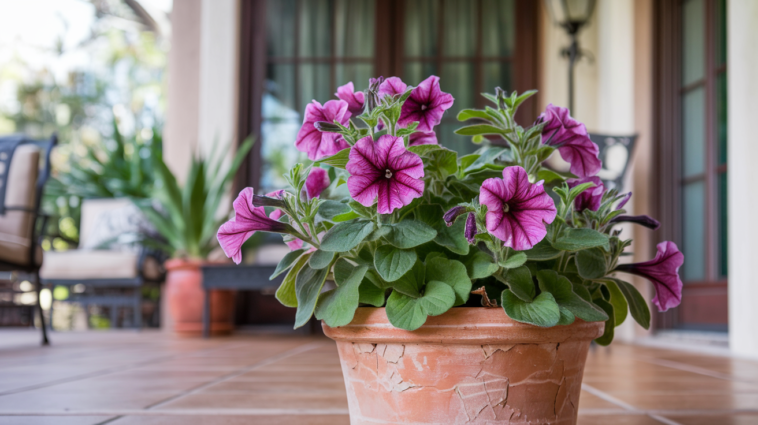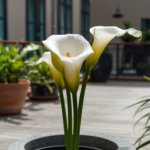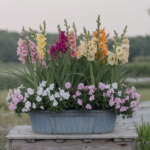Petunias are one of the most popular flowering plants for container gardening, offering a vibrant and long-lasting display of color throughout the growing season.
These versatile flowers thrive in pots, hanging baskets, and window boxes, making them a favorite choice for both beginner and experienced gardeners. With the right care, petunias can provide months of beautiful blooms.
Here’s everything you need to know about growing and caring for petunias in pots.
Choosing the Right Pot

Selecting the right container is essential for the success of your petunias. A pot with drainage holes is crucial, as petunias do not tolerate standing water. A container that is at least 12 inches in diameter is ideal for accommodating multiple plants and encouraging healthy root growth. Hanging baskets and window boxes are also excellent options for trailing petunia varieties.
Terracotta and ceramic pots offer breathability, helping to prevent root rot, but plastic containers are lighter and easier to move around. If using a decorative pot without drainage holes, be sure to add a layer of gravel at the bottom or use a plastic liner with drainage to prevent waterlogging.
Selecting the Best Soil
Petunias thrive in well-draining, nutrient-rich potting mix. A high-quality commercial potting soil with added organic matter, such as compost or peat moss, provides the best foundation for healthy growth. Avoid using garden soil, as it tends to be too dense for container gardening and can lead to poor drainage and root diseases.
To further improve aeration and drainage, consider adding perlite or sand to the potting mix. A slightly acidic to neutral pH (6.0-7.0) is ideal for optimal nutrient absorption.
Planting Petunias
When planting petunias in pots, start with healthy young plants or seedlings. Space them about 6-12 inches apart, depending on the variety, to allow for proper airflow and growth. For a lush and full display, you can plant multiple petunias in a single container, but avoid overcrowding, as it can lead to disease issues.
If planting from seeds, start them indoors about 10-12 weeks before the last frost. Lightly press the seeds into the soil surface without covering them, as they need light to germinate. Keep the soil moist and provide warmth for successful germination.
Light Requirements
Petunias thrive in full sun, needing at least 6-8 hours of direct sunlight daily. Placing the pots in a sunny location ensures continuous blooming and prevents leggy growth. If growing petunias indoors, position them near a south-facing window or supplement with grow lights.
In hot climates, some afternoon shade may help prevent the flowers from wilting, but too much shade can result in fewer blooms and weaker plants. Rotate the pots periodically to ensure even light exposure on all sides.
Watering and Humidity
Consistent watering is key to keeping petunias healthy. Water the plants when the top inch of soil feels dry, ensuring thorough watering so that excess drains out of the pot. Avoid letting the soil dry out completely, as this can stress the plants and reduce flowering.
During hot summer months, potted petunias may require daily watering. However, be cautious of overwatering, as soggy soil can lead to root rot. Water in the morning to allow the foliage to dry out before night, reducing the risk of fungal diseases.
Fertilizing Petunias
Petunias are heavy feeders and benefit from regular fertilization. Use a balanced, water-soluble fertilizer (such as 10-10-10 or 20-20-20) every two weeks during the growing season. A slow-release granular fertilizer can also be added at the time of planting to provide consistent nutrients.
For enhanced blooming, consider a fertilizer with higher phosphorus content, such as a bloom booster formula. Organic options like compost tea or fish emulsion can also provide nutrients while improving soil health.
Pruning and Deadheading
Regular pruning and deadheading encourage continuous blooms and prevent the plants from becoming leggy. Remove spent flowers by pinching or cutting them off to redirect energy into new growth. Trim back long, straggly stems by one-third to promote bushier, more compact growth.
For trailing or spreading petunia varieties, occasional trimming helps maintain a neat and full appearance. If plants start to look sparse in mid-season, a light pruning can rejuvenate them and encourage a fresh flush of flowers.
Managing Pests and Diseases
Petunias are relatively low-maintenance but can be affected by common garden pests such as aphids, spider mites, and caterpillars. Inspect the plants regularly and treat infestations with insecticidal soap or neem oil.
Fungal diseases like powdery mildew and botrytis can occur in humid conditions or when air circulation is poor. Prevent these issues by spacing plants adequately, watering at the base rather than overhead, and removing affected leaves promptly.
Overwintering Petunias
Petunias are typically grown as annuals, but they can be overwintered indoors in colder climates. Before the first frost, take cuttings from healthy plants and root them in pots indoors. Alternatively, potted petunias can be brought inside and placed near a bright window, though they may slow their growth during the winter months.
For those in warm climates (USDA zones 9-11), petunias may survive year-round if provided with adequate protection from extreme cold.
Repotting Petunias
If petunias become root-bound or the soil appears depleted, repotting can help rejuvenate them. Choose a slightly larger container with fresh potting soil and carefully transplant the petunias. This is best done in early spring before the growing season begins.
When repotting, inspect the roots for any signs of disease or rot, and trim away any damaged sections before replanting. Repotting also allows you to refresh the nutrients in the soil, ensuring healthy growth.
Conclusion
Growing petunias in pots is a rewarding and easy way to bring vibrant color to your home, patio, or garden. By providing the right container, soil, sunlight, and regular care, you can enjoy a stunning display of blooms from spring through fall.
With proper watering, fertilizing, and pruning, petunias will thrive and brighten up any space with their cheerful, abundant flowers. Whether cascading from a hanging basket or filling a decorative container, petunias are a versatile and delightful choice for any gardener.


